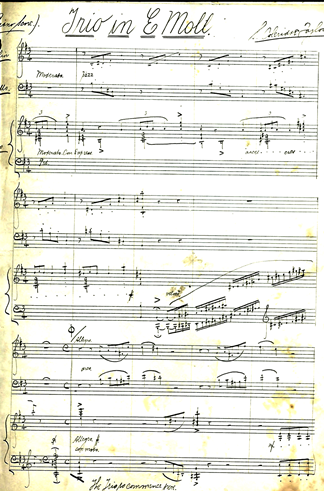Presents
Samuel Coleridge-Taylor
Piano Trio in e minor
Samuel Coleridge-Taylor (1875-1912) was born in London, the product of a mixed race marriage, his father, a doctor, being an African from Sierra Leone and his mother a white Englishwoman. His father returned to Africa when he was a small boy and he was brought up by his mother in Croydon. His musical talent showed itself early and he was admitted to study the violin at the Royal College of Music where he eventually concentrated on composition when his gifts were ascertained. His teacher was the renowned composer, Sir Charles Villiers Stanford. He and his compositions gained considerable fame during his lifetime. His oratorio Hiawatha's Wedding Feast for a time became as popular as Handel's Messiah and Mendelssohn's Elijah. He made several visits to the United States because of his interest in American Negro cultural life. His fame was such that he made three visits the United States. On one visit, he was invited to the White House by Theodore Roosevelt. On another, he was asked to conduct the New York Philharmonic. At the time, Mahler was its music director. Coleridge-Taylor's success was such that they nicknamed him the "African Mahler."
 His
Piano Trio in e minor dates from 1893 at which time he was studying with
Stanford. It was not published during his lifetime and the manuscript score,
which languished in the library of the Royal College of Music in London where he
studied, was only made available recently. Although Coleridge-Taylor was 18
years old at the time he composed the trio, Stanford immediately recognized his
young student's immense talent, later calling him the most gifted of all of the
many students he taught that subsequently became famous composers. Not surprisingly, the music
shows the influence of the idols of Standford's own teachers--Carl Reinecke and
Friedrich Kiel. That is to say, on can hear the influence of Mendelssohn and to
a lesser extent Schumann. It is not a large work and is in three relatively
short movements. It opens with a brief relatively slow Moderato introduction
which quickly gains speed and leads to an exciting and dramatic Allegro con moto.
The middle movement marked Scherzo, allegro leggierio, is lively and
light-hearted. The finale, marked Allegro con furiant, after three dramatic
chords, takes off full speed, the music in someways recalling the Mendelssohn
piano trios.
His
Piano Trio in e minor dates from 1893 at which time he was studying with
Stanford. It was not published during his lifetime and the manuscript score,
which languished in the library of the Royal College of Music in London where he
studied, was only made available recently. Although Coleridge-Taylor was 18
years old at the time he composed the trio, Stanford immediately recognized his
young student's immense talent, later calling him the most gifted of all of the
many students he taught that subsequently became famous composers. Not surprisingly, the music
shows the influence of the idols of Standford's own teachers--Carl Reinecke and
Friedrich Kiel. That is to say, on can hear the influence of Mendelssohn and to
a lesser extent Schumann. It is not a large work and is in three relatively
short movements. It opens with a brief relatively slow Moderato introduction
which quickly gains speed and leads to an exciting and dramatic Allegro con moto.
The middle movement marked Scherzo, allegro leggierio, is lively and
light-hearted. The finale, marked Allegro con furiant, after three dramatic
chords, takes off full speed, the music in someways recalling the Mendelssohn
piano trios.
Our edition, edited by senior editor Santo Neuenwelt, is based on the above-mentioned manuscript, pictured on the left. Although an early work, it is certainly strong enough to be heard in concert and can be warmly recommended to amateur ensembles.
Parts: $29.95